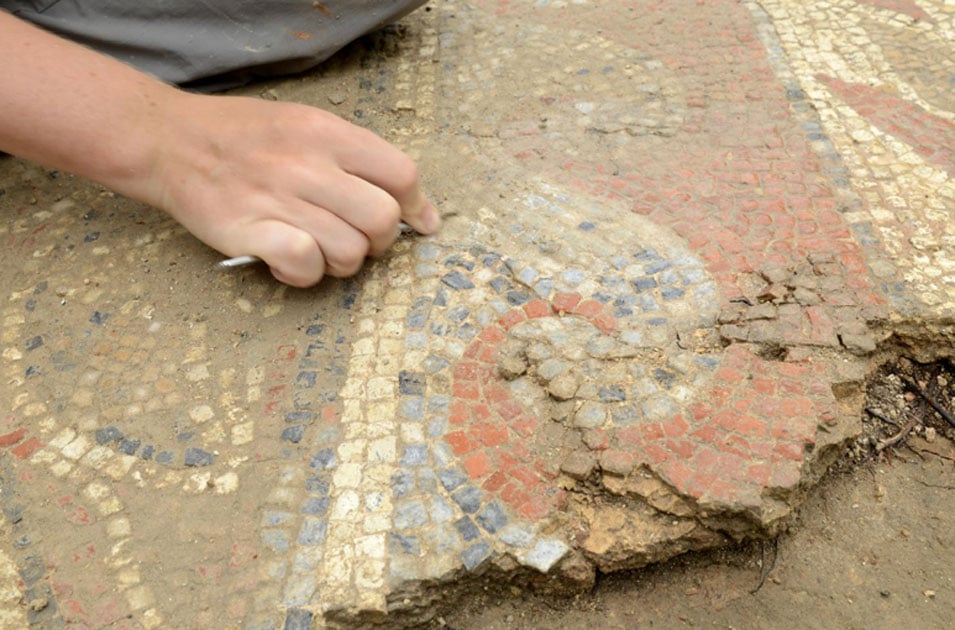Race to Recover Elaborate Ancient Roman Mosaics Unearthed in France
A team of archaeologists has recently discovered the ruins of an opulent 5th-century Roman palace in Auch, a commune in southwestern France. The team claims to be eager to excavate the site as they battle against time.
Landowner Discovers the Impressive Ruins Accidentally
As the Connexion reports, the newly found palace has been deserted for more than 1,600 years and it was located close to the center of the ancient Roman city of Augusta Auscorum – the capital of the province of Novempopulanie – near the center of the modern French town of Auch. It was discovered by the landowner who was digging foundations to construct a new house. He couldn’t imagine that only 50 cm below the surface he was digging he would discover the amazing 2-metre-deep ruins of an ancient aristocratic Roman palace, which possessed luxurious private baths and remarkable mosaics on the ground.
Excavation of Roman Imperial-era domus in Auch (Credit: © Jean-Louis Bellurget, INRAP)
Archaeologists Have to Race Against Time
Soon after he notified the local archaeological authorities, l’Institut National de Recherches Archéologiques Préventives (INRAP) has been trying to unravel the huge aristocratic home’s history and background. Additionally, the team of archaeologists doesn’t have much time left for investigation as the land has to be returned to the owner no later than this September. Archaeologists estimate that the ruins date from the first to the fifth century AD, as the building was reconstructed many times. “In the beginning, it was a private habitat. At the time, it was a building with earth walls,” Pascal Lotti, archaeologist at Inrap and scientific leader of the excavation, told Connexion. And added, “In the second century, the cadastre (land registry document) was modified, and in the course of the third century, this great house was set up, which would undergo two major restructurings, as evidenced by the three levels identified by the researchers.”

4th century mosaic floors excavated (Credit: © Jean-Louis Bellurget, INRAP)
Impressive Mosaics Amaze Archaeologists
The team of archaeologists has been particularly impressed by the large, prepossessing, colorful mosaics, which are expected to be removed during this month. The mosaics contain several geometric and floral motifs, leaves of ivy, laurel and acanthus; friezes with waves, others with egg-shaped patterns, separated by tridents; octagons with five-leafed flowers and squares separated by three-strand braids. An impressed Mr. Lotti couldn’t hide his excitement in his statements as Connexion reports, “It was not just a dwelling. It was also a place of representation, so it had to be fairly stunning,” he said. Mosaics were seen as a form of fine art by both the ancient Greeks and Romans, who assembled small pieces of colored glass, ceramic, stone, or other materials into an image. Mosaics became particularly popular art form during the time of the Roman Empire, although they were used both before and after this period.

A large-handled 'canthare' vase in the mosaic (Credit: © Jean-Louis Bellurget, INRAP)
Coin Reveals the Age of the Aristocratic Domus
Archaeologists didn’t have any particular difficulty in dating the palace’s age since the discovery of a coin portraying Emperor Constantine I (272-337 AD) helped them conclude that the domus came into existence after the year 330 AD. The luxurious residence also possessed two underfloor heating systems, a technique that was first used by the Minoans and was further developed later by the Romans. Just a step from the excavation, other mosaics were also found, most likely from an earlier stage of the house. Furthermore, at another even deeper level was spotted a third mosaic adorned with four black tesserae forming a cross.

There is a floral motif theme in many of the mosaics at the domus in Auch (Credit: © Jean-Louis Bellurget, INRAP)
The dig is ongoing, and according to INRAP, as we already mentioned the archaeologists don’t have much time in their hands as the land will have to be returned to its owner by September.
Top image: The site is being carefully excavated before the mosaics are removed. (Credit: © Jean-Louis Bellurget, INRAP)


















